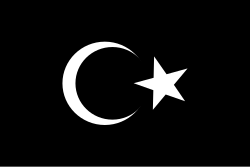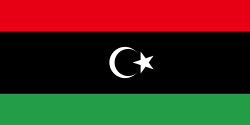Senussiové
| Dynastie Senussi | |
|---|---|
 | |
| Země | |
| Mateřská dynastie | Idrisovci |
| Tituly |
|
| Zakladatel | Muhammad ibn Alí as-Senussi |
| Rok založení | 1837 |
| Konec vlády | 1. září 1969 |
| Poslední vládce | Idris I. |
| Současná hlava | Muhammad as-Senussi (rovněž Idris al-Senussi vznáší nárok na post hlavy rodu) |
| Některá data mohou pocházet z datové položky. | |
Senussi nebo Sanussi je název královské dynastie a muslimského politicko-náboženského hnutí v Libyi a regionu Súdán založené v Mekce roku 1837 Velkým Senussim, Saídem Muhammadem ibn Alí as-Senussi. Senussiové vládli Libyi oficiálně v letech 1951 až 1969, ale již od roku 1917 byli emíry Kyrenaiky (východní třetina Libye).
Původ rodu

Senussiové odvozují svůj původ od proroka Mohameda přes jeho dceru Fátimu, vnuka Hasana a pravnuka Hasana. Řadí se tak dalším muslimským, současným i bývalým panovnickým rodům, které odvozují svůj původ od proroka Mohameda (např. Hášimovci, Alavité, Kásimovci, Fátimovci, atd.) Přes Mohamedova vnuka Hasana, pravnuka Hasana a prapravnuka Abdalláha a jeho mladšího syna Idrise I., který založil v Maroku vlastní dynastie odvozují svůj původ právě Senussiové jako vedlejší větev Idrisidů. Další větev Idrisidů se později stala dynastií Husajnů, která vládla v Tunisku.
Počátky rodu 1787–1860
Dynastie Senussiů byla v historii pro Evropany i ostatní celkově zvnějšku uzavřená, proto se informace o jejich a činech velmi liší. Ačkoli je možné si utvořit určitý obrázek ze života jednotlivých senussiovských šejků, získat jakékoli další podrobnosti je obtížné.
Senussi byl spojován s odklonem od islámské náboženské spirituality a naopak probuzením muslimské politické integrity. Byl ovlivněn hnutím salafi, do kterého zahrnul učení různých súfijských řádů. V letech 1902 až 1913 se členové rodiny Senussiů zúčastnili boje proti francouzské expanzi na Sahaře, stejně jako proti italské kolonizaci Libye na počátku roku 1911. V roce 1951 se vnuk Velikého Senussiho stal králem Libye jako Idris I. Roku 1969 byl král Idris I. svržen vojenským pučem vedeným plukovníkem Kaddáfím. Třetina libyjské populace zůstala na straně hnutí Senussi.
Hlavy rodu (po roce 1951)
- Idris I. – 1969 († 1983)
- Hasan as-Senussi – 1969 až 1992 (†), synovec Idrise
- Muhammad as-Senussi – od 1992, syn Hasana
Externí odkazy
 Obrázky, zvuky či videa k tématu Senussiové na Wikimedia Commons
Obrázky, zvuky či videa k tématu Senussiové na Wikimedia Commons
Média použitá na této stránce
Traditional banner of the Senussi and flag of Cyrenaica from 1949-1951.
Autor: Пакко, Licence: CC BY-SA 3.0
Emblem of the Kingdom of Libya, known as the "Crown of Libya", after a design used during 1952-1969.
The constitution of the Kingdom of Libya of 1952 in article 7 describes the flag, but not the emblem. No official description is available at present (due to the restrictions placed on government archives since the military coup of 1969), and the design is reconstructed from many variants in shape and color schemes. The 24dec1951.com website conducted research into the design as represented in official government sources of 1952-1969, and describes the emblem as follows:
- Top Crown adorned with a white Crescent and five-pointed star at its summit, at which five visible side frames originating from a ring at the base converge. The star studded base and frame contain a velvet black head cover like object.
- The Top Crown is supported at its base by two beautiful plantar designs; in the form of three intertwined C and S scroll shapes.
- Two massive “Shoulder” frames contain the body of the crown from the right and left [...]. Each side is a complex formation of intertwined branches in the shape of an S Curve, which is essentially two back-to-back C scrolls; the larger one of which terminates in a large beautiful spiral at the top. [...]
- The background color of the large interior below the Top Crown can be white or transparent, although this is not evident in the picture of the Libyan pound. The background color of the center region surrounding the large white Crescent and Star is black as in the center stripe of the Libyan flag.
- A white ring with thin black borders, surrounds the center large white Crescent and Star.
- Nine five-pointed white stars surround the center ring.
- Large white crescent.
- Five pointed star located well above the perimeter of the crescent. This differs from the flag, which places the star at the extremities of the crescent.
- A Center Crown, seated above the ring containing the Crescent and Star. Its design is identical to the Top Crown, except for being smaller in size.
- Plantar/ floral ornamentation similar to #2 above, providing variation and connectivity to the base.
- At the base, an elegant design that resembles a document scroll with a ring tie at its center. It is noted that the color scheme of the crown is most likely white for the stars and crescents, black and white (or transparent) for spaces, and gold for the crowns and frames. [...]
One of the several maritime flags of Ottoman Tripolitania used during Karamanli era (1711-1835). Based on Johnson's new chart of national emblems of 1868. A similar flag, with the crescents moved towards the hoist, is recorded in the 1750s as the naval flag of the "Turkish Emperors" (Türckische Kayser) in Flaggen aller seefahrenden Nationen.[1]
Autor: BlinxTheKitty, Licence: CC0
Senussi Dynasty Traditional Bannner, Similar to the Flag of Cyrenaica and The Stand of King Idris




